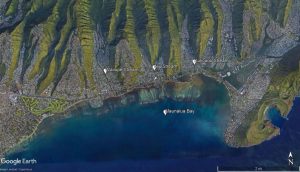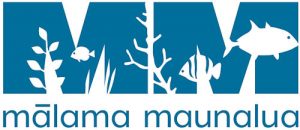Mālama Maunalua and partners are using a holistic approach to restore coastal water systems in Maunalua Bay based on the traditional Hawaiian practice of ahupua‘a. In order to accomplish restoration from the mountains to the reef, local groups work together while educating and engaging the community to improve the overall water quality and decrease flooding in the entire watershed.

Maunalua Bay is on the southern shore of O‘ahu island where ten watersheds feed into the coastal waterway.
Maunalua Bay, Hawai‘i
Maunalua Bay sits on the southern shore of O‘ahu island. Ten watersheds feed into the 6.7 square mile bay, which is listed on the Clean Water Act 303(d) list as an impaired open coastal waterway. Stormwater runoff in urban areas and invasive species (both plant and animal) in the upland forests contribute to increased flooding in the watershed and the overall poor water quality in the bay. Three watersheds in particular—Wailupe, Niu, and Kuli‘ou‘ou—experience flash flooding and contribute to the delivery of high levels of nonpoint source pollution to the bay.
Urban development plus the introduction of invasive species have fragmented the habitats of Maunalua Bay watershed. To address flooding and improve the habitats and water quality in the rivers feeding the bay, both the 2021 East Honolulu Sustainable Communities Plan and 2020 Hawai‘i Climate Change Mitigation and Adaptation Commission Annual Report recommend reintegrating a holistic watershed management plan based on the traditional Hawaiian social-environmental subdivision system of ahupua‘a — managing land and aquatic resources as a self-sustaining unit from mountains to reef.
Traditional Ahupua‘a Management in Modern Hawai‘i
Building on the system of ahupua‘a, Mālama Maunalua (MM) designed a project to address the poor water quality issues in Maunalua Bay. Funded by a National Fish and Wildlife Foundation Coastal Resilience Fund grant, MM formed a partnership to reduce flooding and pollution in the Wailupe, Niu, and Kuli‘ou‘ou watersheds by focusing on the upland mountain forests and mid-watershed urban stream runoff. Making the connection from the mountains to the reef, this project connects with work that MM is also doing to protect the reefs of Maunalua Bay.
Project Partners Include:
Ko‘olau Mountains Watershed Partnership (KMWP) and Protect and Preserve Hawai‘i (PPH) conducted assessments and submitted permits for upwards of 550 acres for ungulate (i.e. feral pig) fencing in the upland forest regions of the watershed. PPH also works with nearly 120 volunteers each month to remove invasive species and plant native seeds. In a combined event with MM, volunteers created 200 seed bombs—or balls of dirt packed with native seeds—to be deployed into the Niu Valley forests. Through events and public outreach, over 100 people have been reached directly to educate the community about the ahupua’a restoration efforts.

Top left: MM advertises for green infrastructure assessments; Bottom left: KMWP and PPH make seed bombs with volunteers; Right: MM installs a raingarden with volunteers. Images: MM and KMWP
To address urban stormwater run-off in the central watershed, MM has partnered with Birchline Planning LLC to conduct flowpath modeling. The modeling helps to identify priority locations for using green infrastructure. MM and Roth Ecological Design International have also conducted green infrastructure assessments on two commercial properties and about a dozen homes within the watershed. The assessments identify the kinds of green infrastructure elements that are best suited for the locations. Using the NFWF funds, they will follow-up with interested parties to do the installations.
While this project focuses on the land portions of the watershed, the overall ahupua‘a model is extended through MM’s work on nearshore algae removal and coral reef restoration. MM is a key partner in the Restore with Resilience partnership, planting thermally tolerant corals to mitigate reef loss.
Mountains to Reef
Using a holistic ahupua‘a approach to restore coastal water systems in Maunalua Bay requires local groups to work together in partnership. While educating and engaging the community, MM and partners have coordinated efforts from the mountains to the reef to decrease flooding and improve the overall water quality of the watershed.
The views and conclusions contained in this document are those of the authors and should not be interpreted as representing the opinions or policies of the U.S. Government or the National Fish and Wildlife Foundation and its funding sources. Mention of trade names or commercial products does not constitute their endorsement by the U.S. Government or the National Fish and Wildlife Foundation or its funding sources.


